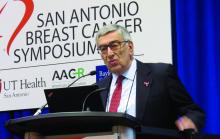SAN ANTONIO – Adding atezolizumab, an anti–programmed death-ligand 1 (PD-L1) monoclonal antibody, to neoadjuvant chemotherapy failed to significantly improve pathologic complete response (pCR) rates in women with triple-negative breast cancer in the randomized NeoTRIPaPDL1 trial.
A slight improvement in pCR rates, which is a secondary study endpoint, was seen in the subgroup of PD-L1-positive women, but the difference in that group also failed to reach statistical significance, Luca Gianni, MD, said at the San Antonio Breast Cancer Symposium where he reported these initial results from the open-label multicenter trial.
“In the intent-to-treat analysis, the rate of pathological complete response was 43.5% with atezolizumab, and 40.8% without atezolizumab, for a net difference of 2.63% and an odds ratio of 1.11,” said Dr. Gianni, president of the Fondazione Michelangelo in Milan.
Among patients whose tumors tested positive for PD-L1, the pCR rates were 51.9 and 48.0% with atezolizumab versus without, but this difference was also not significant.
On multivariate analysis accounting for treatment group, PD-L1 expression, and disease stage, the only variable significantly associated with the pCR rate was PD-L1 positivity, and this association was similar in both treatment groups, he noted (odds ratio, 2.08).
“The same trend toward a numerically higher rate of clinical overall response with atezolizumab was observed on clinical grounds, but again, at 76.1% vs. 68.3% – not statistically significant,” he said.
The complete response rates with atezolizumab versus without were 29% vs. 26.1% and the partial response rates were 47.1% vs. 42.3%, respectively; 3.6% vs. 4.9% of patients in the groups had stable disease, and 5.8% vs. 8.4% had progressive disease.
The NeoTRIPaPDL1 study enrolled 280 adult women with HER2-negative, estrogen receptor– and progesterone receptor–negative early high-risk or locally advanced unilateral triple-negative breast cancer (TNBC). Participants were randomized to receive neoadjuvant carboplatin AUC 2 and intravenous abraxane at a dose of 125 mg/m2 on days 1 and 8 either with or without 1,200 mg of IV atezolizumab on day 1. Both regimens were given every 3 weeks for eight cycles, followed by surgery and four cycles of an investigator-selected anthracycline regimen.
The primary study endpoint is event-free survival at 5 years after randomization of the last patient, but this initial report from the trial focused on pCR, Dr. Gianni said.
Tolerability of treatment was similar with both regimens, except for an increase in abnormal liver transaminases “that tended to be significantly more frequent with atezolizumab administration,” he said, noting that the “toxicity was very short lived and didn’t limit the possibility of administering the drug.”
“Immune-mediated adverse events and infusion reactions clustered around the atezolizumab arm, as expected, and mostly consisted of infusion reactions and hypothyroidism,” he added.
Infusion reactions occurred in 8.0% and 5.7% of patients in the atezolizumab versus no atezolizumab groups, and grade 3 or greater infusion reactions occurred in 1.4% versus 0.7%. Hypothyroidism occurred in 5.8% and 1.4%, respectively, with no grade 3 or greater events.
“All other toxicities were either mild or very rare,” he noted.
TNBC is an aggressive subtype of breast cancer with poor prognosis. Progression to distant metastases is often rapid, as is development of resistance chemotherapy, Dr. Gianni explained, adding that chemotherapy is currently the only treatment for early-stage TNBC.
Chemotherapy works in some patients, but relapse and resistance are common even after good initial responses; therefore, he and his colleagues examined the effects of immune checkpoint inhibition added to neoadjuvant chemotherapy, reasoning that the combination might boost the antitumor immune response.
Atezolizumab in combination with nab-paclitaxel is now approved by the Food and Drug Administration for the treatment of some patients with locally advanced or metastatic TNBC. The approval was based on findings from the IMpassion130 study showing a significant progression-free and overall survival benefit with atezolizumab when added to nab-paclitaxel in PD-L1-positive metastatic TNBC.
In a press statement, Dr. Gianni noted that the pCR findings he reported from the NeoTRIPaPDL1 study “may indicate that there is no therapeutic benefit to adding atezolizumab to neoadjuvant chemotherapy compared to chemotherapy alone, or may simply mean that any beneficial effects of the combination will be seen in the long term.”
“Pathologic complete response does not provide information about the quality of response, which is why we did not use it as the primary endpoint for this study. Further analyses may reveal differences in the quality of response between the treatment groups,” he added, noting that the study is limited in that reported results apply only to the initial effects of the combination treatment and do not account for effects of therapies administered after surgery.
Follow-up for the primary endpoint of event-free survival and other efficacy endpoints in the NeoTRIPaPDL1 trial is ongoing, and molecular studies are also underway, Dr. Gianni said.
Biological samples collected from patients before, during, and after neoadjuvant treatment are being examined for lymphocyte infiltration, DNA mutations, and/or levels of circulating tumor DNA, and may reveal differences between the treatment groups, he explained.
This study was sponsored by Roche and Celgene. Dr. Gianni has been an advisor and/or consultant for numerous pharmaceutical companies. He has received support for research from Daiichi Sankyo, Zymeworks, and Revolution Medicines and is a coinventor on a patent for PD-L1 expression in anti-HER2 therapy.
SOURCE: Gianni L et al. SABCS 2019. Abstract GS3-04.


